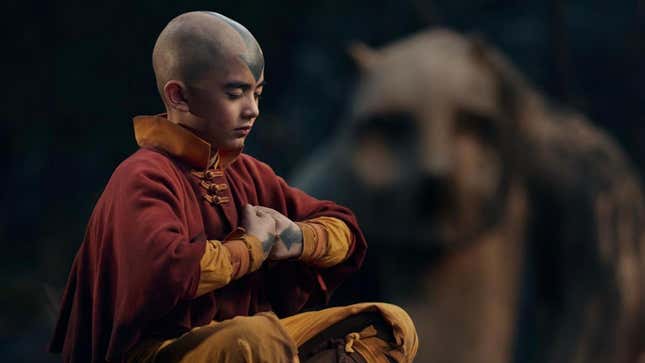With Avatar: The Last Airbender premeiring later in the month, Netflix has gradually started to pull back the curtain on its adaptation of the 2005 cartoon. The show was never going to be a complete one-to-one of the original, but it does feel like some of the additions and tweaks to the show—like tampering down Sokka’s sexist behavior—don’t entirely get why they existed in the source material to begin with.
One interesting move the new show’s making is a remixing of storylines from the show. The biggest is bringing in Zuko’s (Dallas Liu) family into the picture much sooner—his father Ozai (Daniel Dae Kim) and sister Azula (Elizabeth Yu) have expanded roles here compared to the small slices of them in the cartoon’s first season. Showrunner Albert Kim told IGN it helps flesh out “why [Zuko’s] doing what he’s doing and set that in the context of his family dynamic, and how he fits in with his father and sister.” And it’s similarly why Zuko’s duel with his father—which was briefly shown in a flashback, resulting in his scar and exile—will be more presented in full here.
Having Zuko’s family be more prominent here—Kim said Azula essentially gets a prequel ahead of her meatier material in future seasons—is a move any newer adaptatioin would make. Other choices are up for debate, though: instead of being a kid trying to avoid being the Avatar, Aang (Gordon Cornier) will have more “narrative drive,” said Kim. Rather than him, Katara, and Sokka getting swept up in weekly misadventures, he’ll get a vision early in the season that spurs him to go to the Northern Water Temple for a Waterbending master. The vision “gives him more narrative compulsion going forward,” which is just a fancy way of saying there won’t be much in the way of worldbuilding detours that gave the original Avatar its charm.

Of the changes, Kim said he views the new show as “a remix, not a cover.” While he and the writers knew there were certain characters and plot points to do faithfully, they couldn’t be a slavish recreation. The key goal was “feeling your way throughout the process,” while also “making sure it feels like it was Avatar in spirit.” But some of the updates on a character level feel like they could miss the mark: Katara won’t have “certain roles” in the group dynamic because “some gender issues didn’t quite translate.”
Like with Sokka, the Water Tribe’s sexism and Katara’s role as team mom are two fundamental parts of the original show that were atively addressed and used to further character arcs. They weren’t just there for the sake of it, and by admitting a want to “guard against that kind of stuff,” it makes the adaptation’s writers feel like they’re afraid of characters growing and being messy or annoying in spots. Nickelodeon’s Avatar was a show for children, but it understood that kids can be mean and destructive, to themselves and especially one another or those they love, something this new one is seemingly trying to sand over because character arcs must be sacrificed for likability.
I loved the original Avatar when I was 12 and growing up, and still do, but it wasn’t high art. So stuff like the examples above, plus Kim saying it “can’t just appeal for kids,” can’t help but get at the nerves. The new show wasn’t going to please everyone, because nothing can. But in trying to make the show hit for fans and also people who are high on Game of Thrones (which, there’s probably a greater overlap of those two than we think?), it feels like Netflix isn’t entirely sure what it wants the show to be other than “another live-action Avatar.”
We’ll find out for sure when Avatar: The Last Airbender comes to Netflix on February 22. IGN’s full discussion with Kim and series director Jabbar Raisani can be read here.
Want more io9 news? Check out when to expect the latest Marvel, Star Warsand Star Trek releases, what’s next for the DC Universe on film and TVand everything you need to know about the future of Doctor Who.







